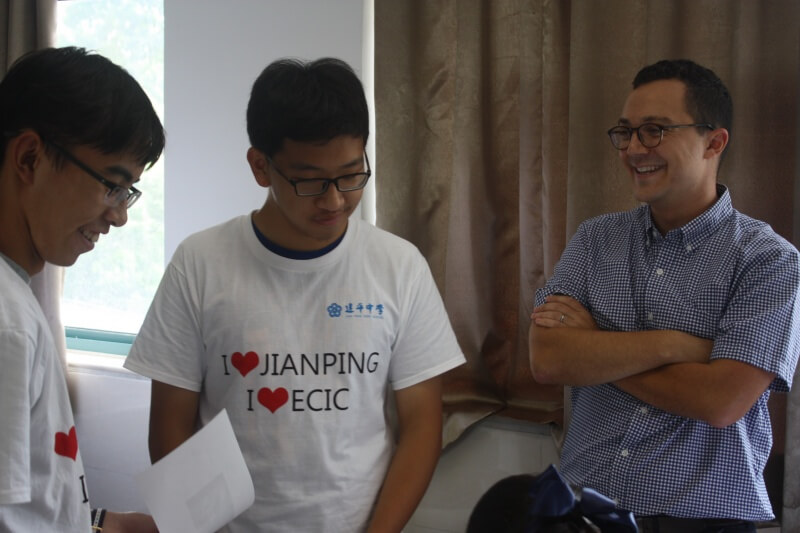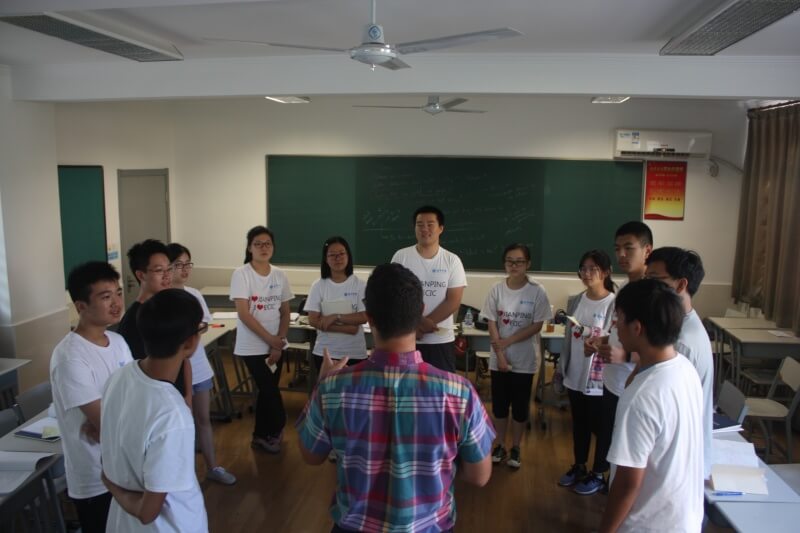Last spring I called an old classmate, Andrew Rejan, for some advice. I was in the first stages of crafting a syllabus for Philosophy & Literature, a new English elective at CA, and I knew he’d have some ideas. Somewhere toward the end of a long conversation that touched on everything from Yaa Gyasi’s novel Homegoing to the joys of swimming laps, he paused: “Hey, do you want to teach in Shanghai for a week this summer?”
And so four months later, I found myself in front of 12 rising juniors in a semi-air-conditioned classroom at Jianping High School in the Pudong district of Shanghai. I began by asking the students to move the desks from rows into a circle. They looked at me like I had asked them to do headstands.
I had traveled there with 12 other teachers, most from New York City, some from UC Berkeley and University of New Mexico, and all connected by Sheridan Blau, the head of the English Education department at Columbia University’s Teachers College. I first met Sheridan as a graduate student at Teachers College in 2011. In his Teaching of Writing course, I began to consider the ways that writing is also a form of thinking, to question the orthodoxy of thesis-based essays, to value the power of authentic student-directed inquiry. I also developed friendships with people like Andrew. I still return to Sheridan’s 2003 book, The Literature Workshop, every summer, often the evening before the first day of classes.
The program at Jianping began when Sheridan was approached by an alumnus of Columbia Business School who had observed that Chinese students who were attending American colleges and universities often struggled with free-form discussion-based courses. In a typical class at Jianping, a teacher lectures, asks a question, and a student formally stands up to answer. With Sheridan leading the way, our task was to develop a week-long intensive course that engaged students with the types of reading, writing, speaking and thinking that would be expected from them at colleges in America, Canada, or the United Kingdom.
“I began by asking the students to move the desks from rows into a circle. They looked at me like I had asked them to do headstands.”
Shanghai in August is a hot, muggy, dynamic, outrageously large city with surprises at every turn. One night we ate guacamole at a swanky restaurant perched on the 87th floor of the Grand Hyatt; the next day we ate chicken feet for lunch at the school cafeteria. Some of my preconceived notions about China were confirmed: the incredible amount of new construction; evidence—often in the form of luxury cars—of a rising middle class; delicious, complex food; and, of course, a neon skyline straight out of Ridley Scott’s Blade Runner. But the trip also debunked several of my expectations: the air was clean, the sidewalks immaculate; there is a bike-sharing system that puts New York City’s to shame; and the city seems equally interested in preserving tradition as it is participating in a modern, cosmopolitan world.
On whole, the experience was most impactful as a form of professional development. So here are a few stray observations, takeaways, and insights that might apply to the work we do with students at CA.
- The value of faculty collaboration: I feel lucky to work with colleagues at CA who are so open to collaborating on curriculum or working through a text together or visiting each other’s classes. I’ve worked at schools where this is the exception rather than the norm. Collaboration is not an incredibly novel approach, but my experience at Jianping emphasized that effective collaboration often grows organically out of a shared purpose—an authentic problem—and passionate participants. In Shanghai, I lived and breathed teaching for ten days. I ate breakfast, lunch, and dinner with my colleagues, celebrating successful lessons, dissecting the flaws in those that had failed, sharing student work, talking pedagogy. It made me value my incredible colleagues at CA while simultaneously highlighting the importance of learning from educators who are outside of our community.
- Intensives: When I returned, I often heard the same response from friends and colleagues: “How much could you actually accomplish with students in such a short period of time?” A lot, it turns out. With a curriculum built around the concept of “Vision, Perspective, and Ways of Seeing,” and complex texts from writers like Annie Dillard, Oliver Sacks, Janet Simon, and Wallace Stevens, students had a lot to think about, and perhaps paradoxically, a lot of time to think. When you’re working with the same group of students for seven or eight hours a day, you’re never worried about the approaching “bell,” you’re never going to see a student who is secretly studying for an upcoming test in another class, and you seemingly always have time for reflective, metacognitive exercises at the end of the day. By our second to last day, each student in my class had produced nearly 20 pages of writing. More importantly, their conceptual thinking had grown both broader and deeper.
- Intellectual freedom and educational contexts: While discussing Plato’s famous allegory of the cave from The Republic, I asked my students who might be responsible for releasing us from the shackles of our own caves. “VPN,” one student bluntly responded, referring to the “virtual private networks” that allowed him to bypass Chinese internet restrictions. The next day, as part of a writing prompt, I showed part of a music video by the Icelandic singer Björk. Later, a student pulled me aside: “You probably shouldn’t have shown that video. Björk was banned from China in 2008 after yelling ‘Tibet! Tibet!’ at a concert in Shanghai.” Indeed, I had been warned to avoid the three Ts: Tibet, Taiwan, and Tiananmen, but I had no idea that Björk was off-limits, too. This type of censorship is, at its core, counter to my philosophy of education—and to CA’s mission—and yet, it’s something I rarely think about and rarely don’t take for granted. These experiences also highlighted for me the way that all teaching and learning exists in cultural and social contexts. It’s part of what makes teaching so incredibly challenging, but it’s also what makes classrooms—whether in Shanghai or Denver—such vibrant, complex, meaningful spaces.



